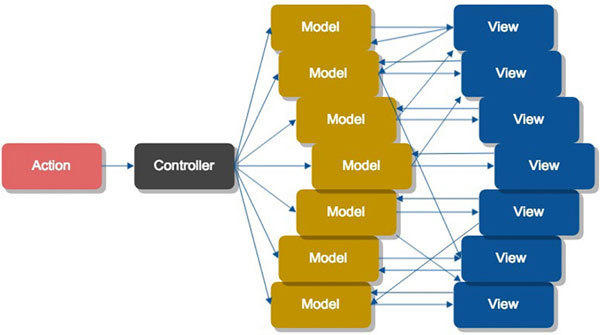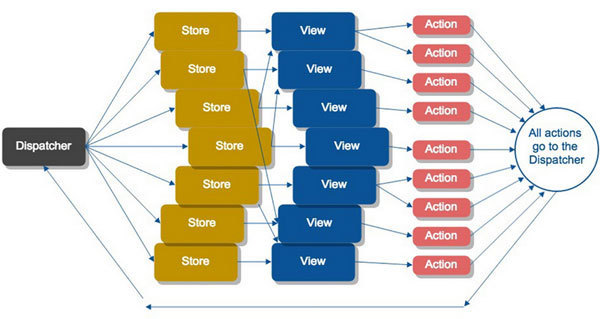First introduction to React
First time I met React
I vaguely remember attending an offline event in 2015 and hearing the word React for the first time. The speaker at the time was Guo Dafeng. He played a performance comparison video about ember, angular and react: React.js Conf 2015. At that time, I was mainly engaged in angularjs development, and I was well aware of the pain of angular's performance problems when the page was complex. After seeing the performance comparison in this video, I was instantly impressed by React. Now let’s review React together~
View library
React is different from MVC frameworks such as AngularJS and Backbone. It is a Javascript library launched by Facebook to build user interfaces. It only focuses on the view layer (i.e. V in MVC ), is a library for building front-end reusable UI components. At the same time, when data changes, React will update and render the corresponding components in a timely and effective manner. For increasingly complex front-end interfaces, especially for web applications where data is constantly changing, React can efficiently and accurately reflect the changing data on the page.
View State Machine
In traditional web applications, when data changes, changes in DOM nodes need to be synchronized. React treats the interface as a state machine:
UI = f(states)
When the interface state changes, React will promptly and effectively update and render the corresponding components according to the given state, and the rendering performance of the same state will be consistent.
JSX
In traditional web applications, templates or HTML instructions are used to build user interfaces, but React uses JSX (an XML-like syntax that extends ECMAScript) declarative writing method, which has advantages over templates:
JavaScript is A flexible and highly scalable programming language
unifies the page markup language and view logic, making the view easier to expand and maintain
Without string splicing, the view content is integrated into JavaScript, reducing the existence of XSS vulnerabilities
Efficient update
When the application state changes, React can efficiently update and render components and interfaces:
Virtual DOM: Use lightweight description objects in memory to represent the structure and style of real DOM nodes through Javascript
Difference Quantitative algorithm: Generate a minimum set of Diff trees efficiently and quickly
Batch update: effectively merge multiple updates of the state into one update operation
React uses virtual DOM to describe a real DOM. When the application state changes, A minimum set of Diff trees is produced through an efficient difference algorithm, and multiple update operations are merged into one, which reduces direct operations on the actual DOM, thereby greatly improving performance.
Event Proxy
React uses an event proxy mechanism, which can maintain the consistency of event bubbling, cross-browser execution, and even use HTML5 events in IE8. React implements a "synthetic event" layer, which eliminates the compatibility issues between IE and W3C standard implementation. Events bound through JSX are bound to "synthetic events". "Synthetic events" will be bound to the top layer of the component through event delegation, and the bound events will be automatically destroyed when the component is unloaded.
Flux one-way flow
Flux is an application architecture launched by Facebook. It advocates a one-way data flow:


Let’s take a look at the data flow relationship diagram under the MV* and Flux application architecture:
MV*

Flux

From the above figure we can see that Flux one-way data flow makes the application status Become predictable and traceable, and can easily achieve the following goals:
Easy testability, reproducibility
Diagnostic debugging based on time travel
Undo and replay functions
isomorphic/universal
React capabilities Run on the server to achieve SEO optimization, experience optimization, performance optimization and other purposes; at the same time, we only need to learn React once and can write it anywhere. You can use it to write Web, mobile, VR and other applications.

Hot AI Tools

Undresser.AI Undress
AI-powered app for creating realistic nude photos

AI Clothes Remover
Online AI tool for removing clothes from photos.

Undress AI Tool
Undress images for free

Clothoff.io
AI clothes remover

AI Hentai Generator
Generate AI Hentai for free.

Hot Article

Hot Tools

Notepad++7.3.1
Easy-to-use and free code editor

SublimeText3 Chinese version
Chinese version, very easy to use

Zend Studio 13.0.1
Powerful PHP integrated development environment

Dreamweaver CS6
Visual web development tools

SublimeText3 Mac version
God-level code editing software (SublimeText3)

Hot Topics
 1378
1378
 52
52
 How do I create and publish my own JavaScript libraries?
Mar 18, 2025 pm 03:12 PM
How do I create and publish my own JavaScript libraries?
Mar 18, 2025 pm 03:12 PM
Article discusses creating, publishing, and maintaining JavaScript libraries, focusing on planning, development, testing, documentation, and promotion strategies.
 How do I optimize JavaScript code for performance in the browser?
Mar 18, 2025 pm 03:14 PM
How do I optimize JavaScript code for performance in the browser?
Mar 18, 2025 pm 03:14 PM
The article discusses strategies for optimizing JavaScript performance in browsers, focusing on reducing execution time and minimizing impact on page load speed.
 What should I do if I encounter garbled code printing for front-end thermal paper receipts?
Apr 04, 2025 pm 02:42 PM
What should I do if I encounter garbled code printing for front-end thermal paper receipts?
Apr 04, 2025 pm 02:42 PM
Frequently Asked Questions and Solutions for Front-end Thermal Paper Ticket Printing In Front-end Development, Ticket Printing is a common requirement. However, many developers are implementing...
 How do I debug JavaScript code effectively using browser developer tools?
Mar 18, 2025 pm 03:16 PM
How do I debug JavaScript code effectively using browser developer tools?
Mar 18, 2025 pm 03:16 PM
The article discusses effective JavaScript debugging using browser developer tools, focusing on setting breakpoints, using the console, and analyzing performance.
 Who gets paid more Python or JavaScript?
Apr 04, 2025 am 12:09 AM
Who gets paid more Python or JavaScript?
Apr 04, 2025 am 12:09 AM
There is no absolute salary for Python and JavaScript developers, depending on skills and industry needs. 1. Python may be paid more in data science and machine learning. 2. JavaScript has great demand in front-end and full-stack development, and its salary is also considerable. 3. Influencing factors include experience, geographical location, company size and specific skills.
 How do I use source maps to debug minified JavaScript code?
Mar 18, 2025 pm 03:17 PM
How do I use source maps to debug minified JavaScript code?
Mar 18, 2025 pm 03:17 PM
The article explains how to use source maps to debug minified JavaScript by mapping it back to the original code. It discusses enabling source maps, setting breakpoints, and using tools like Chrome DevTools and Webpack.
 Getting Started With Chart.js: Pie, Doughnut, and Bubble Charts
Mar 15, 2025 am 09:19 AM
Getting Started With Chart.js: Pie, Doughnut, and Bubble Charts
Mar 15, 2025 am 09:19 AM
This tutorial will explain how to create pie, ring, and bubble charts using Chart.js. Previously, we have learned four chart types of Chart.js: line chart and bar chart (tutorial 2), as well as radar chart and polar region chart (tutorial 3). Create pie and ring charts Pie charts and ring charts are ideal for showing the proportions of a whole that is divided into different parts. For example, a pie chart can be used to show the percentage of male lions, female lions and young lions in a safari, or the percentage of votes that different candidates receive in the election. Pie charts are only suitable for comparing single parameters or datasets. It should be noted that the pie chart cannot draw entities with zero value because the angle of the fan in the pie chart depends on the numerical size of the data point. This means any entity with zero proportion
 The difference in console.log output result: Why are the two calls different?
Apr 04, 2025 pm 05:12 PM
The difference in console.log output result: Why are the two calls different?
Apr 04, 2025 pm 05:12 PM
In-depth discussion of the root causes of the difference in console.log output. This article will analyze the differences in the output results of console.log function in a piece of code and explain the reasons behind it. �...




